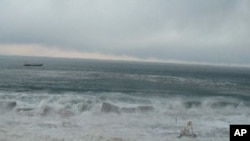Japanese nuclear regulators say they were told four days before the March 11 earthquake that the Fukushima nuclear plant could be hit by a far-larger tsunami than it was designed to withstand.
The regulators told reporters Wednesday that the plant's operators, Tokyo Electric Power Company, determined in 2008 that the plant could be hit by a tsunami more than 10 meters high. But the findings, based on a computer simulation of a major undersea earthquake, were not passed along until March 7 of this year.
The Nuclear and Industrial Safety Agency says it responded to the report by asking for urgent countermeasures at the plant, which was designed to withstand a tsunami of only 5.7 meters. The tsunami that hit the plant four days later is estimated to have been as high as 15 meters.
The 10-meter estimate prepared in 2008 was based on an assumption of an 8.2-magnitude earthquake in the Pacific Ocean east of the plant. The actual earthquake had a magnitude of 9.0, one of the five most powerful ever recorded.
The resulting tsunami destroyed all sources of power to cooling systems at the plant, leading to core meltdowns in three of its six reactors. Workers have been struggling ever since to halt radioactive leakage into the ocean, air and soil around the plant.
TEPCO Reported Tsunami Threat 4 Days Before Fukushima Disaster






